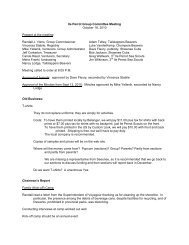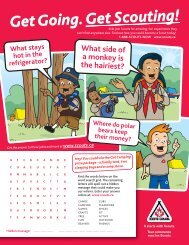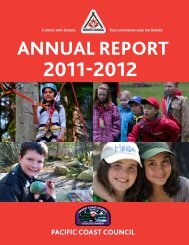Beaver Leader's Handbook - Scouts Canada
Beaver Leader's Handbook - Scouts Canada
Beaver Leader's Handbook - Scouts Canada
Create successful ePaper yourself
Turn your PDF publications into a flip-book with our unique Google optimized e-Paper software.
Your <strong>Scouts</strong> <strong>Canada</strong> council office can also provide information on how other colonies have integrated<br />
children with disabilities. Take time to visit these colonies and talk with their leadership<br />
teams. Some councils also have special service teams available to provide assistance and training.<br />
Whatever the child’s disability, use a team approach to discuss all the options and potentials,<br />
gather information from knowledgeable adults, and communicate openly, keeping the child’s<br />
best interests at heart.<br />
CHILD ABUSE<br />
(See Duty of Care in Chapter 2)<br />
As a leader, you may meet a child whom you suspect is being abused physically, emotionally,<br />
sexually, or through neglect. What should you do? You have a legal responsibility to report the<br />
suspected abuse to the police or child welfare authorities, who will assume responsibility and<br />
provide the best possible help for the child. Confidentiality is of the utmost importance.<br />
Never try to investigate or counsel yourself. These duties belong to professionals who can<br />
ensure the safety and well-being of the child. Your role is to provide support and share positive<br />
experiences with the child and all the other <strong>Beaver</strong>s.<br />
A useful book on this subject for both parents and leaders can be found on <strong>Scouts</strong> <strong>Canada</strong>’s web<br />
site (www.scouts.ca) under Resources. It’s called, How to Protect Your Children From Child<br />
Abuse: A Parent’s Guide.<br />
REFERENCES<br />
6-8<br />
This chapter only briefly discusses the subject of understanding, communicating and working<br />
with children. You’ll find more information in the easy-to-read references below.<br />
4 How to Talk So Kids Will Listen and Listen So Kids Will Talk, by Adele Farber and Elaine Mazlish.<br />
4 Encouraging Children to Learn, by D. Dinkmeyer and R. Dreikurs.<br />
4 Raising Kids Who Love to Learn, by Children’s Television Workshop.<br />
4 Miseducation and the Hurried Child, by David Elkind<br />
Notes<br />
!








